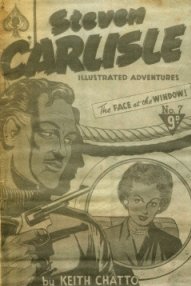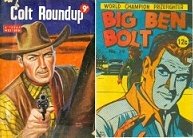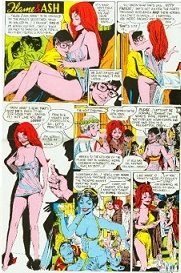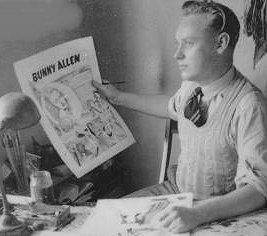| Keith Chatto, Australian illustrator
and cartoonist
KEITH Chatto was one of Australia's most prolific
illustrators and cartoonists in the post World War 2
period. He is variously remembered for being the first
Australian artist to illustrate a full-length comic
episode of The Phantom, for his Skippy the Bush Kangaroo
comics, for his myriad pulp fiction covers, his original
cartoon titles and for his abiding interest in
"glamour" illustration.
Ronald Keith Chatto was born in 1924. He studied in
Sydney, where Jim Russell of Smith's Weekly is said to
have encouraged him to take art classes. He apparently
worked for Greater Union Theatres art department and drew
recognition charts for the Air Training Corps before
joining the RAAF.
During the Second World War he served first as a
trainee telegraphist and later as a draughtsman. He
worked for a time in RAAF headquarters illustrating air
training magazines and booklets, later moving to the
Directorate of Education illustrating pamphlets,
magazines and posters. Describing his time in Western
Queensland after the war he wrote (in an article in Flame
magazine) of "designing and painting murals in a
welfare canteen" and running a beauty contest,
"painting a portrait of the winning WAAF which
was ultimately presented to her".
 |
Drawing women definitely appealed to Chatto,
as his later career demonstrated. |
In an autobiographical article in the lurid 1970s
Australian men's magazine Flame, Chatto described how, on
discharge from the RAAF, he submitted an idea for a comic
strip called Destiny Scott to The Sydney Morning Herald.
This was accepted and published.
"A year later," he wrote, "I
began work on a fictionalised version of the life of Sir
Francis Drake called the Sea Dog. This was bought by The
Herald, but to my knowledge never published.
"In 1947 I submitted a story to the Allied
Authors and Artists Group which published comic books and
magazines. The name of the character was Bunny Allen and
she was a country girl, well endowed for her sixteen
years who had adventures in the country and city areas
and appeared monthly in Tex Morton's Wild West comic.
This ran for several years and was popular. It was also
the first comic to be drawn in line and tone. This came
about when the publishers decided to go to an offset
process and in order to make the comic more realistic,
like photographs, I added half tones. Also in 1947, I
drew a comic character called Captain Midnight for Fatty
Finn's comic, another of the Allied Authors and Artists
stable."
 |
Also in 1947 Chatto became
resident or staff artist for The Australian
Sunbather, a nudist magazine, published by
Ashworth Publications. Apart from doing the
layout, illustrated headings, retouching of
photographs, he dabbled in photography and
produced two nudist comic strips. One told the
story of "John and Mary Moore" – a
suburban couple who go bush in their birthday
suits and encounter snakes, sharks and rich
yachtsmen with pretty daughters. The other strip
was called "Pages from a Naturist
Diary". 1948 saw "The
Buccaneer", also drawn for Fatty Finn's
comic, "The Glamor Girl" (a story about
the adventures of a model) for Cooee comic. 1949
saw "Buck Davey Rides Again", a comic
based on the radio character created by Jack
Davey, the radio star of the 40s and 50s.
|
"About this time I began illustrating
magazine stories for periodicals published by Associated
General Publications, the forerunner of the Horwitz
publishing group," Chatto wrote.
"During 1949-50, a Melbourne publisher, Atlas
Publications, commissioned me to create a western
Character for a comic book, I called it The Lone Wolf.
This was the first time I was responsible for a whole
book, from the cover to all its contents. This character
continued for several years and was relatively popular."
In 1954 another Victorian publisher, Larry Cleland
Publishing Co., commissioned Chatto to produce a full 32
page comic book on a detective character of his own
devising named Steven Carlisle.
 |
"From the very start it
was to run into censor troubles because of its
sophisticated theme and drawings. Despite being
held up by Melbourne University as fine example
of Australian publishing and art, it came to an
end some seven issues later. It was a pity,
because I had enjoyed producing the magazine and
it was a first of its type. Perhaps a little too
far advanced for its time, though it carried as a
centre spread an education feature, on printing,
publishing, photography etc., but in those days
censorship was at its most ridiculous stage.
Comics were intensely screened, as were other
magazines by the civic fathers. |
"Violence, and remember this was a detective
story, could not be portrayed in detail ... guns could be
drawn, but must not be shown exploding. A stabbing or any
of the natural action that one would expect from a
detective story continuously ran into censor troubles.
The Lone Wolf began running into the same restrictive
thinking and slowly the comic hey-day began to
deteriorate."
Chatto became disillusioned and switched to other
forms of illustration including record sleeves and covers
for pulp novels, which he churned out at the rate of up
to six a week by the mid-1950s. Cleveland Publishing
commissioned him to illustrate a radio serial called
"The Twilight Ranger" and then another western
hero called "El Lobo, the Man from Nowhere".
 |
As comics and cartooning
declined as a money-making field, Chatto
diversified into photographic - mainly girlie
pictures. When television appeared it
immediately captured Chatto's imagination and he
began to involve himself in filming and film
production.
In the mid-1960s he was commissioned by Page
Publications to provide covers for American and
English comic and pulp titles to which they had
reprint rights. This arrangement saw him produce
a wide variety of covers for everything from
crosswords to romance, detective stories and
westerns – not to mention his beloved girlie
pictures.
Chatto always wanted to publish something
really raunchy, and Flame magazine provided him
the opportunity, commissioning him to draw a
full-colour, full-page strip called "Flame
and Ash", a swinging 1970s couple.
|
"It was my feeling that the subject matter
should be approached with humour in mind and situations
contrived with tongue well and truly in cheek,"
he wrote.
"As far as I am concerned, the old days when
many Australian artists lived drawing comic strips either
for newspapers or comic books are just that . . . the old
days, and I doubt if we will ever see their like again."
 |
Flame and Ash was followed by
"Randy and Cee Cee" in Flame's
stablemate Fury. Keith Chatto kept working well
into his old age and he died in 1992 at the age
of 58. #
|
Back to Collecting Books & Magazines.
|






